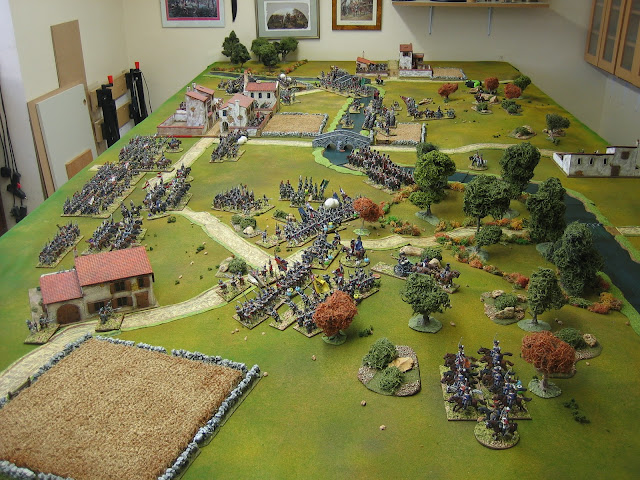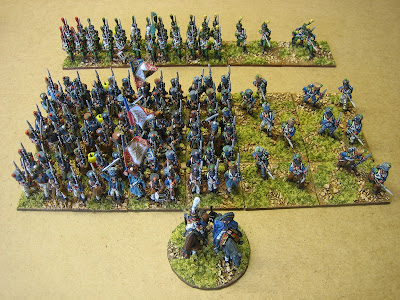Peter drew the lot for the British and Graham the French. Peter rolled up for a skilled commander (with a 'skilled' sequence deck) and Graham rolled up for an average one (and an 'average' sequence deck).
They rolled off to decide who got to choose which the side of table take and, against the odds, Graham won. He chose to defend the town.
Following this, using a similar set up procedure to that used in FoB 2, Peter was fated to see where three of the enemy commands would deploy and Graham found that one of his command groups would have a delayed arrival. Unfortunately, for Graham, the delayed command was Division 1, which had all of his best infantry in it. It wouldn't arrive until the end of the evening.
The French left and centre. Division 2 formed line through the town and Division 4 were place on the extreme left.
Facing them, the British deployed Division 2 on their right and Division 3 in the centre.
The right wing of Division 2 extends out of the other side of the town, here supported by their guns. On the right, Division 3 is supported by the cavalry of Division 5.
A closer shot of the deployment of British Division 2 in the centre of the British battle line. To its left flank stands the British heavy cavalry of Division 4.
Before I could take a shot of the British left, Division 1 supported by the Light Dragoons of Division 5, was on the move, advancing with alacrity across the ford and through the woodland at the foot of the hill.
The hill would be the focus of most of the action on the first evening. The British won most of the early initiative and siezed the hill before the French could move against it. From the heights, the British poured fire onto the the French below, sending one of the French infantry units retreating to the rear before it managed to rally at the table edge.
With the battle around the hill getting underway, the British make their attack general along the whole front.
At this point, Graham, with his best troops delayed, had insufficient troops to launch any further counterattacks of his own. His frustration is evident.
Note the French infantry unit scuttling to the rear after taking heavy punishment from the British firing down from the hill. We all though this unit was lost but, Division 3 is led by an excellent officer (Up 2) and it will rally at the table edge in the nick of time.
The British roll over one of the Bridges.
This morning, I took some shots of the action as it appeared at the end of the first night's play.
An overview of the action on the hill.
Note the infantry unit to the rear of the French 1st Hussars. This unit has been rallied and is now heading back into the fray. So far, neither side has actually lost a unit!
French Division 1 has finally arrived to the right of the town.
The British hold the Bridge on the French left.
A close up of British troops defending the heights on the British left.
Below them, the French attack has stalled. The British are closing for the kill. In the distance, the British heavy cavalry is licking its lips in anticipation of a lively pursuit.
The troops of French Division 1. This is the best division in the French army; if it hadn't been delayed the narrative of the battle so far would have been much different.
The French of Division 2, sheltering in the town.
An overview of the whole field. It's looking pretty good - especially if you are rooting for the British.






































